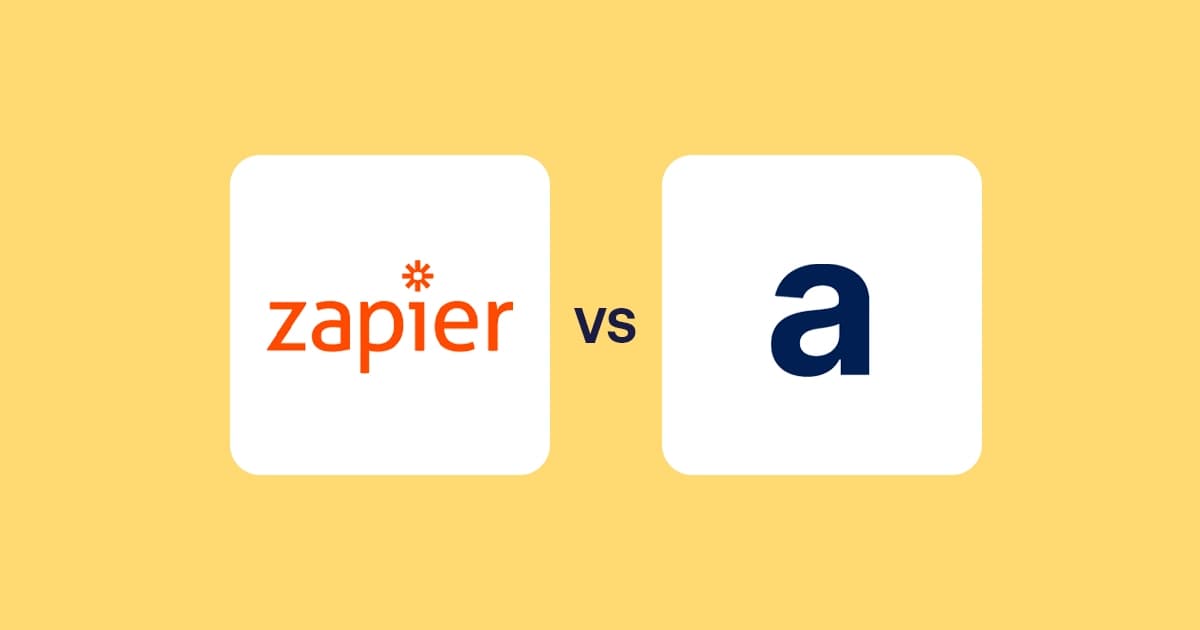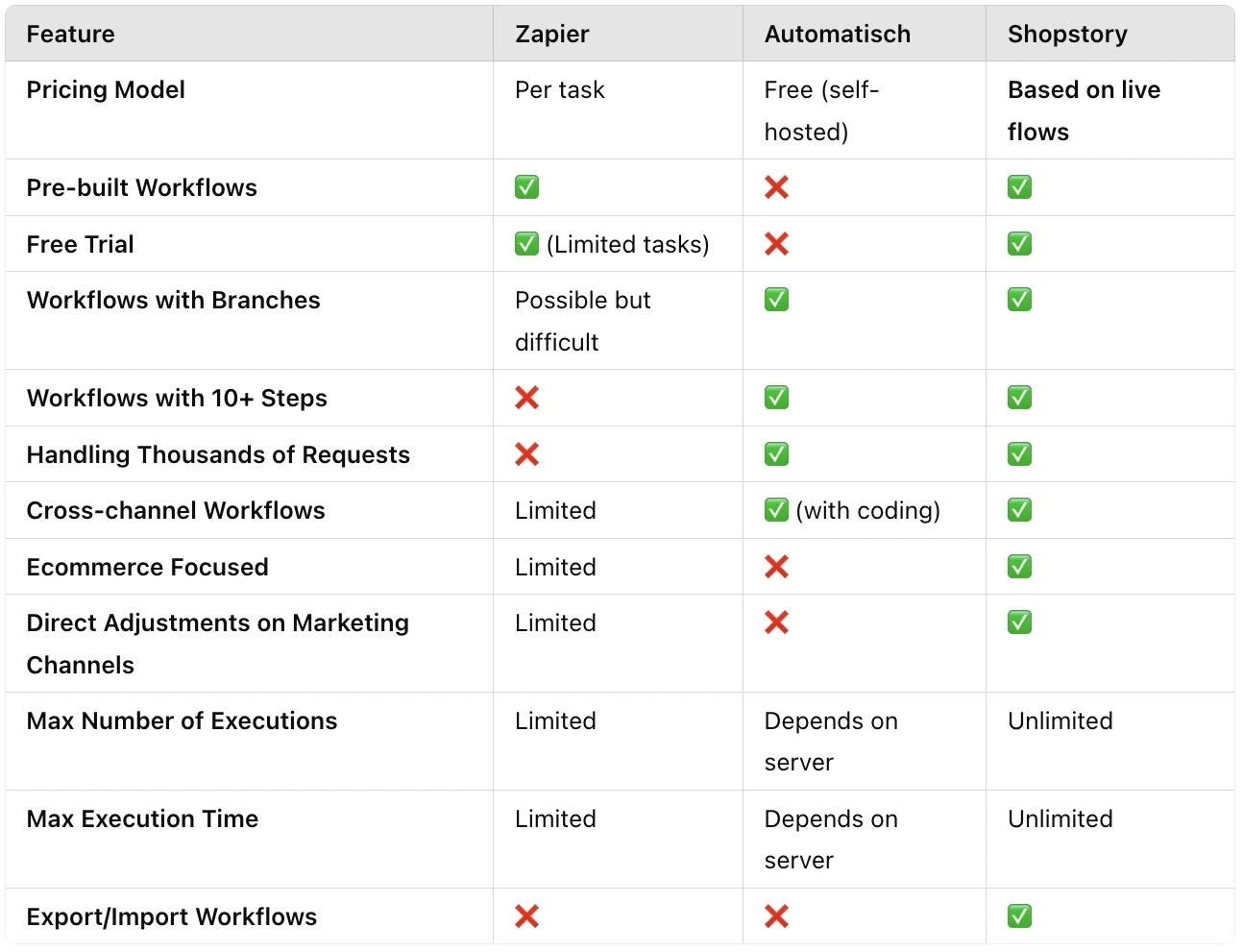MARKETING AUTOMATION
Zapier vs Automatisch.io (and why Shopstory is better)
20.09.2024

When choosing between Zapier and Automatisch.io for automating workflows in ecommerce and marketing, it's important to understand the strengths, limitations, and unique features of each platform. Both tools provide automation solutions but serve different types of users and business needs. This comparison will outline how Zapier and Automatisch.io stack up against each other and introduce Shopstory, a more specialized solution designed for ecommerce businesses, marketing agencies, and performance marketers.
TL;DR
Zapier is ideal for beginners in automation due to its wide range of integrations and ease of use. Automatisch.io, being open-source, allows for greater customization but requires technical expertise to implement. However, neither platform is specifically optimized for ecommerce or marketing workflows. Shopstory stands out as a better option, offering tailored, no-code automations with native integrations for ecommerce and marketing, making it a cost-effective and powerful tool for growing businesses.

Ein Vergleich von Zapier, Automatisch.io und Shopstory
1. Zapier vs Automatisch.io: A Summary
1.1 Pricing Model
Zapier:
Zapier’s pricing model is based on the number of tasks (or actions) executed in workflows. While it offers a free plan for light users, costs can increase quickly for businesses with more complex workflows. Every step in a workflow counts as a task, making it an expensive option for large-scale automations.
- Free Plan: 100 tasks per month, 5 workflows.
- Paid Plans: Start at $19.99 per month for 750 tasks.
Automatisch.io:
Automatisch.io, as an open-source platform, is free to use but comes with additional considerations. Businesses will need to account for hosting, security, and possibly hiring technical expertise to set up and manage the platform. Although the software itself is cost-free, this model is less intuitive and requires more hands-on management.
- Free: But with associated hosting and development costs.
- Open-source: Allows for full customization, but requires technical resources.
Key takeaway:
Zapier’s pricing can escalate as automation needs grow, while Automatisch.io provides more flexibility but requires technical investment. Both may become complex or costly for businesses focusing on scaling operations.
1.2 User-Friendliness
Zapier:
Zapier is known for its intuitive, drag-and-drop interface that allows users with no technical expertise to set up automations easily. It is
especially strong for small workflows and quick setups. However, as workflows grow in complexity, Zapier’s ease of use can diminish, with conditional branches and multiple steps becoming harder to manage efficiently.
Automatisch.io:
Automatisch.io is much more geared towards technically savvy users. While it offers more flexibility for customization, this requires coding knowledge and familiarity with managing an open-source platform. Non-developers may find it challenging to set up and maintain workflows, limiting its accessibility for those without technical expertise.
Key takeaway:
Zapier offers ease of use for non-technical users, while Automatisch.io is better suited for developers or technical teams looking for customization. However, the technical demands of Automatisch.io may make it less appealing for businesses without in-house developer resources.
1.3 Integrations
Zapier:
Zapier integrates with over 5,000 apps, covering a wide variety of business tools and platforms. Whether it’s Google Sheets, Slack, Salesforce, or Shopify, Zapier allows users to connect many apps with relative ease. However, some integrations, such as those for CRM or ecommerce platforms, often require premium subscriptions.
Automatisch.io:
As an open-source tool, Automatisch.io allows businesses to create custom integrations. This can be extremely powerful for technical teams that want to tailor connections between tools exactly to their needs. However, Automatisch.io lacks the large, out-of-the-box integration library that Zapier offers, meaning you'll likely need to build custom connectors.
Key takeaway:
Zapier is ideal for users who need a wide range of out-of-the-box integrations, while Automatisch.io is better suited for businesses with the technical skills to build their own connections. However, Automatisch.io’s reliance on custom development could slow down initial setup compared to Zapier’s immediate access to thousands of app integrations.
1.4 Workflow Complexity and Error Handling
Zapier:
Zapier handles basic automations efficiently but starts to falter when workflows become more complex. With limited error-handling capabilities, troubleshooting issues in multi-step workflows can be cumbersome. This makes Zapier suitable for simpler automations but less ideal for businesses requiring advanced error management.
Automatisch.io:
Automatisch.io offers more flexibility in handling complex workflows since users can modify the code behind the automations. This allows for detailed, custom workflows with advanced error handling and conditions. However, this flexibility comes at the cost of needing more technical expertise to design and manage these workflows effectively.
Key takeaway:
Zapier is user-friendly for simpler workflows, but Automatisch.io offers greater complexity and customization options for those with technical expertise. However, both platforms may require manual intervention for intricate error handling.
1.5 Scalability and Performance
Zapier:
Zapier is scalable to a point, but the costs rise significantly as the number of tasks grows. It’s suitable for small to medium-scale automations but may not be cost-effective for businesses needing to automate thousands of tasks each day. This could make it challenging for companies with large-scale operations to control costs effectively.
Automatisch.io:
Automatisch.io, as an open-source solution, offers scalability in terms of customization and performance, provided the business has the technical resources to manage it. However, scaling with Automatisch.io means taking on the responsibility of managing hosting, performance, and security as your automation needs grow.
Key takeaway:
Zapier can become costly at scale, while Automatisch.io provides more flexibility but requires in-house technical expertise to manage growth effectively. Neither platform is ideal for businesses looking for scalability without increased costs or complexity.
2. Alternative to Zapier and Automatisch.io: Shopstory
While both Zapier and Automatisch.io provide solid automation solutions, they are not tailored to the unique needs of ecommerce businesses, marketing agencies, and performance marketers. Here’s why Shopstory stands out as the better alternative:
2.1 Native Integrations for Ecommerce and Marketing:
Unlike Zapier and Automatisch.io, Shopstory offers deep, native integrations with ecommerce platforms such as Shopify, WooCommerce, and Shopware. These integrations allow businesses to automate tasks across online sales platforms seamlessly. Additionally, Shopstory integrates directly with key marketing platforms like Google Ads and Meta Ads, allowing for advanced, automated marketing strategies.
2.2 No-Code Simplicity with Advanced Workflow Capabilities:
Shopstory is a no-code platform, meaning businesses don’t need to hire developers or technical experts to set up and run complex workflows. Users can automate advanced ecommerce and marketing processes with pre-built templates and an intuitive drag-and-drop interface. This makes Shopstory accessible to a broader audience, from digital marketers to ecommerce managers, without sacrificing functionality.
2.3 Transparent and Scalable Pricing:
While Zapier's and Automatisch.io's costs can rise quickly due to task limits and custom development requirements, Shopstory’s pricing starts at €199 per month, with costs based on live flows rather than task or action counts. This offers a more scalable and predictable pricing model for growing businesses, making it easier to budget for automation without fear of hidden costs or escalating fees as workflows become more complex.
2.4 Advanced Workflow Capabilities for Performance Marketing:
Shopstory goes beyond basic automations to offer tailored workflows designed for performance marketing and ecommerce businesses. Unlike Zapier or Automatisch.io, Shopstory allows for direct adjustments to marketing campaigns, real-time performance tracking, and tailored ecommerce tasks like inventory management. This depth of integration and automation is critical for businesses looking to streamline their marketing operations and boost their ecommerce performance.
Here are five standout workflows in Shopstory:
- Run Google Ads Campaigns on Autopilot (Performance Max): Automatically optimize product performance in PMax campaigns by allocating budgets intelligently.
- Optimize Low-CTR Items (Google Merchant Center): Improve product visibility and click-through rates directly in Google Merchant Center.
- Real-Time Notifications for ROAS Thresholds (Google Ads): Get alerts when campaign performance dips below target ROAS, ensuring timely optimizations.
- Data Structuring for Better Analytics: Automatically convert unstructured text into actionable, structured reports for improved data management.
- Reactivate Late Converting Keywords (Google Ads): Maintain campaign momentum by reactivating keywords that convert over longer periods, ensuring consistent revenue streams.
2.5 Cross-Channel Automations and Advanced Error Handling:
Shopstory not only handles complex ecommerce automations but also allows for cross-channel reporting and marketing campaign management. Users can automate processes like generating comprehensive weekly reports that consolidate data from Google Ads, Meta Ads, and other platforms. Shopstory also includes advanced error-handling capabilities, ensuring smooth operations even in complex workflows.
3. Free Trial
Shopstory offers a risk-free trial with no credit card required, allowing businesses to experience its powerful features before committing to a paid plan. The free trial gives users access to all features, including pre-built ecommerce workflows and marketing automations, ensuring businesses can assess how Shopstory can streamline their operations.
4. Conclusion
Zapier is well-suited for businesses needing basic, no-code automations with extensive app integrations, while Automatisch.io offers greater customization through its open-source model. However, both tools have limitations when it comes to scaling for ecommerce and marketing automation.
Shopstory is a more tailored solution for online shops, marketing agencies, and performance marketers. With no-code simplicity, native ecommerce integrations, and a transparent, scalable pricing model starting at €199 per month, Shopstory is designed to automate and optimize operations efficiently. Businesses can create complex workflows without developer input and enjoy seamless integration with key marketing and ecommerce platforms.
Try Shopstory today and discover how it can revolutionize your ecommerce and marketing workflows.
More to Explore
Discover more insights from our latest articles
© 2025, Shopstory









